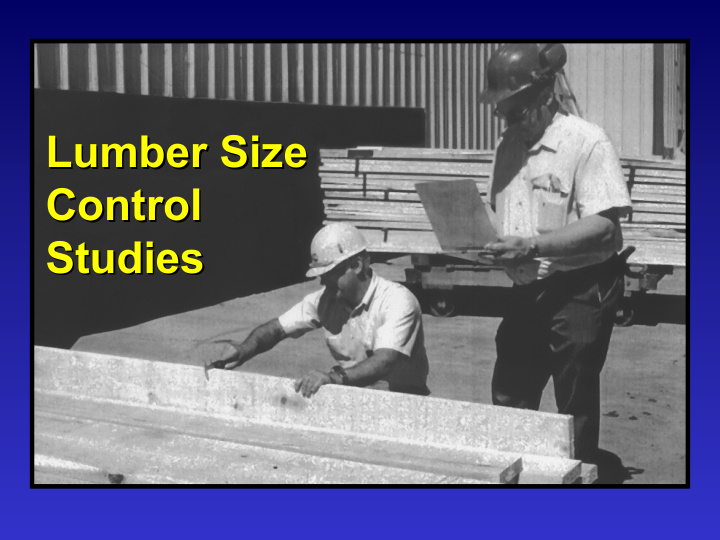



Lumber Size Lumber Size Control Control Studies Studies
Lumber Size Control Lumber Size Control � Troubleshoot machine center performance – Locate & identify problems – Stabilize & improve sawing accuracy – Reduce oversizing � Objective is to improve – Lumber recovery – Sawmill efficiency – Productivity
Lumber Size Control Lumber Size Control Purpose Purpose � Stabilize & improve sawing accuracy—reduce lumber size variation (thick & thin lumber) � Troubleshooting—locate & identify problems in sawing machine centers � Properly adjusting lumber target sizes—control oversizing/undersizing to improve lumber recovery and grade yield
Thick & Thin Lumber
Study Procedures Study Procedures Sampling Sampling � Requires 50-100 study boards per machine center (or saw to saw pocket on gang saws) � Sample 25-50 subgroups of 2 consecutively produced boards (3 successive sawlines or two consecutive pieces on gang saws) � Maintain order of production (i.e., order in which subgroups are manufactured)
Study Procedures Study Procedures Measuring & Recording Procedures Measuring & Recording Procedures � Use a calipers to take 4-5 measurements on both edges on each board (8-10 total measurements per board) � Record measurement data (0.001 in.), time & comments � Note what is going on in the mill during sampling (saw snaking, hit metal, overfeeding the saw)
Study Procedures Study Procedures Study Sampling & Measurement Positions Study Sampling & Measurement Positions
Study Procedures Study Procedures Subgroups of 2 Consecutive Boards Subgroups of 2 Consecutive Boards
Measuring Lumber Thickness Measuring Lumber Thickness Take 8 measurements per board & Take 8 measurements per board & record to the nearest 0.001 inch record to the nearest 0.001 inch
Study Procedures Study Procedures Measurement Location on Study Boards Measurement Location on Study Boards Trailing End Top Edge -First End into Saw Bottom Edge
Lumber Size Analysis Lumber Size Analysis � Components of lumber size variation – Average measured size – Within-, between-, and total-sawing variation � SPC-LSA computer routine—demonstration � Interpretation & troubleshooting—causes of lumber size variation
Components of Lumber Components of Lumber Size Variation Size Variation � Average Measured Size ( ) X � Components of Lumber Size Variation – Total variation (s t ) – Within-board variation (s w ) – Between-board variation (s b ) � Calculated with SPC-LSA program
Interpretation of Lumber Size Variation Interpretation of Lumber Size Variation � Between-board variation—setworks system � Within–board variation—sawing system � Patterns of lumber size variation – End-to-end taper – Edge-to-edge wedging – Thick or thin ends – Snake
SPC-LSA Computer Routine SPC-LSA Computer Routine � Compiled MS-DOS based PC software � Calculates the components of lumber size variation & oversize/undersize � Graphical analysis reports (histogram, variation range graph, specification chart) � Lumber size control charts (average, within- & between-board variation)
Class Exercise - Statistics Class Exercise - Statistics � Described a set of numbers – Calculate average – Measures of variation – Shape of its distribution � Statistics uses simple arithmetic � The hardest thing about “Statistics” is its pronunciation
Recommend
More recommend